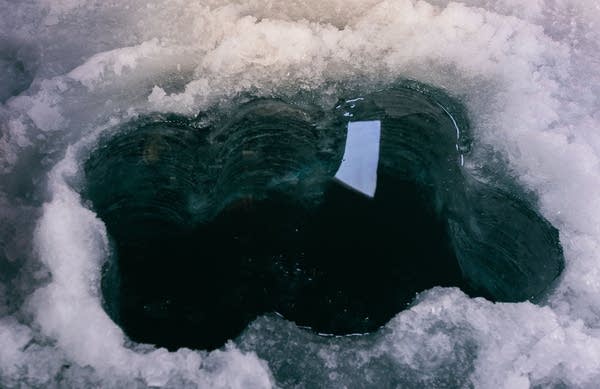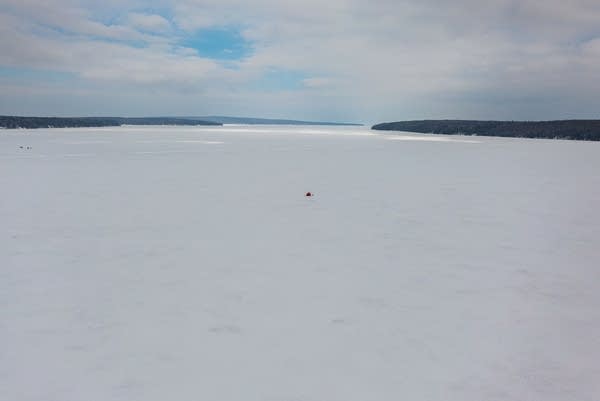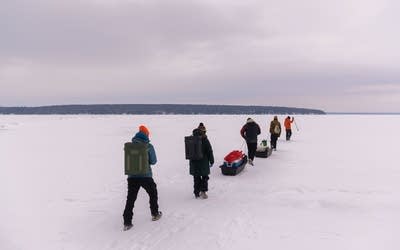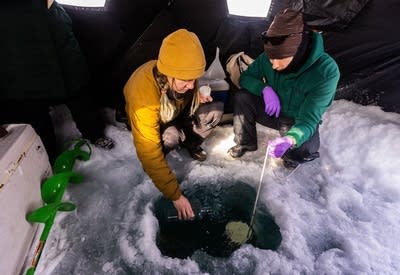The 'Winter Grab' delves into Lake Superior's seasonal secrets
Go Deeper.
Create an account or log in to save stories.
Like this?
Thanks for liking this story! We have added it to a list of your favorite stories.
Scientists have a pretty good understanding of what goes on in the Great Lakes during the summer. But they don't know nearly as much about Lake Superior and the other lakes during winter.
That's significant because winter is when the lakes are experiencing their most dramatic impacts from climate change. So this month, researchers around the Great Lakes joined together for what they called the “Winter Grab," to fill in some of those information gaps, and raise awareness about those changes.
The wind whipped across the frozen surface of Lake Superior last week, as researchers lugged sleds filled with scientific monitoring equipment off shore from Bayfield, Wis.
Turn Up Your Support
MPR News helps you turn down the noise and build shared understanding. Turn up your support for this public resource and keep trusted journalism accessible to all.
"Alright, let's check one more time. We don't have to go too far, actually," said Kirill Shchapov, a researcher at the University of Minnesota Duluth's Large Lakes Observatory, as he checked their location on his phone.
His team was among dozens of people from 19 government and academic institutions sampling nearly 30 sites across the Great Lakes as part of the “Winter Grab." Others took snowmobiles on to the ice; some even took air-powered fan boats or hitched rides on ice breakers.
"We're here!” Shchapov shouted, and the team launched into action.
Scientists chose this spot because it's easily accessible, and a part of Chequamegon Bay that typically has reliable ice in the winter. It's also deep, nearly 100 feet of water, so it's representative of other locations in the lake farther away from shore.
While others quickly set up an ice fishing tent for protection from the wind, Shchapov used an auger to drill a hole in the ice, to measure how deep light penetrates into the water.

That's one of the key questions scientists have. Sunlight is needed for algae to grow, which forms the base of the food chain.
Researchers then duck into the tent, out of the howling wind, where they drill another big hole and chisel out a large blue chunk of ice.
They slowly lower down a container on a long rope to gather water samples at various depths.
Shchapov grew up in Siberia, where as a young boy he remembers tending to livestock outside when the temperature plunged below negative 50 degrees Fahrenheit.
"I just love snow and ice. It's in my blood, I think," he said.
As an undergrad he studied Lake Baikal, the world's deepest lake. Now as a PhD candidate he's studying Lake Superior, the world's largest freshwater lake by surface area.
The world's biggest, coldest lakes are experiencing some of the most dramatic impacts of a warming climate. Annual maximum ice cover on Lake Superior has declined more than 7 percent a decade for the past half century.
Scientists are still racing to determine the consequences of that decline in ice, as well as other changes, like more runoff into the lakes from larger and more frequent rainstorms.

But some implications are already fairly well understood. Declining ice cover, for example, may have a severe impact on whitefish, an important commercial fish species.
Whitefish spawn in late fall in shallow reefs along the shore. If there isn’t ice to protect the eggs, they can get destroyed by severe winter storms.
“In the years where there is not a lot of ice cover, those eggs become really susceptible,” said Ted Ozersky, a biologist at the University of Minnesota Duluth who’s leading the “Winter Grab.”
Ozersky said a similar relationship has been observed in Lake Erie, where the egg of yellow perch — another important commercial species — appear to survive at much higher rates following colder winters.
Shchapov hopes this project not only fills in some of those winter information gaps, but also draws attention to the importance of winter research.
"Because we're in need of it because of climate change. It's affecting winter, it's affecting ice, it's affecting people who you know, depend on ice and other recreational activities during the winter."
Frigid weather, frozen ropes

But research in the winter is challenging. The day before, Schapov's equipment kept freezing up while trying to gather data on Green Bay in Lake Michigan.
"I mean, just to get one sample, you have to haul your stuff out, drill your holes, get it big enough to drop your equipment through, hope your equipment works in the cold, that it doesn't get too icy," said Audrey Huff, another PhD candidate at UMD's Large Lakes Observatory working on the project. And then they have to repeat the process for the next sample, and the one after that.
While most researchers had good luck with the weather this year, a crew from the National Oceanic and Atmospheric Administration's Great Lakes Environmental Research Laboratory wasn’t able to get to one of their sites on Lake Erie because of unsafe ice conditions, even in an airboat.
Ashley Elgin, a research ecologist for NOAA, said it was a good experience to confront the logistical challenges, and hopefully “demystify” winter research.
“And hopefully going forward … people will say, OK, we did it. It was hard but not that hard. There's a lot we don’t understand about winter due to [the fact] it's difficult to get out. But it's important to know what's happening in the winter to build a complete understanding of species interactions,” said Elgin, who studies invasive species such as zebra and quagga mussels.
Ozersky, the UMD biologist who organized the “Winter Grab,” says there has long been a perception, even among some scientists, that not much happens in the Great Lakes during the winter.
"I think there was this self-reinforcing cycle of ignorance where we think that, OK, winter is boring,” he said. “Winter is dormant, nothing that's important for the rest of the year, for the open water season, happens in the winter. So there is no real reason to study."
Ozersky said biological productivity does slow down in the lakes in the winter. It's cold, there's less light. But he said it doesn't slow down to the extent people thought.
“There’s this existing paradigm that lakes are quite dead in the winter. And we found that no, they're not,” said Michael Twiss, a biologist at Clarkson University in New York who’s studied algae blooms in Lake Erie year-round.

He said they’ve found even greater concentrations of algae in the winter, growing just as fast as it does in the summer, even though the water is close to zero degrees Celsius.
“So there's a whole winter time ecosystem out there that we really don't know much about at all,” Twiss said. “So if we want to understand what happens in the wintertime, we have to make the measurements.”
Back on the frozen crust of Lake Superior, Huff and Shchapov pull a giant net up through the ice that they use to collect zooplankton in the water column.
"Here we go, much better. Oh yeah!” exclaimed Shchapov. “See those dots swimming around?” he asked, pointing at tiny dark squiggles moving through the water. “[The] large ones are calanoids. And the fast moving cyclopoids."

Those are the tiny critters that form an important link in the food chain between algae and small fish.
These samples will become baseline data to compare to samples gathered in future winters. Part of what they hope will become a much more complete, year round picture of the changes taking place in the Great Lakes.
As Shchapov put it, “If you want to see the whole picture, you have to look at the lake, and sample the lake, the entire year.”








